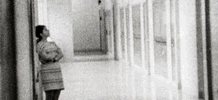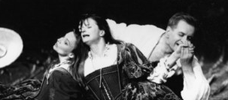Reviews
L’amour joué
Frederick Wiseman
France / USA, 1996
Credits
Review by Adam Balz
Posted on 24 June 2008
Source Zipporah Films VHS
Categories Frederick Wiseman
Lady or lass, bourgeoisie or country girl, nothing is too hot or too cold for him.
—Sganarelle, in Moliere’s Don Juan
Seen today as a profiler of all things wrong with American institutions, the subject of Frederick Wiseman’s 1996 documentary was actually near to the director’s heart: “I had been an admirer of the Comédie-Française for a long time,” he told Julie Salamon in 2004, recalling the years he spent as a student in Paris, where he received discount prices on tickets. You would think this presents a conflict of interest: How can Wiseman claim distance from his subject when he so openly expresses fond, even nostalgic memories of it? How do you deconstruct an institution that is so fully a part of your past, your education, your growth? The easy answer is, you can’t. And one wonders, in viewing La Comédie-Française, whether or not Wiseman’s heart was steadily broken by what he saw: An institution as divided as the American society he momentarily left behind, quietly separated into classes—of performers, of electricians, of stagehands, of the assembled audience, of men and women.
Opening with busts of famed playwrights and an actor’s view of the theatre, its lush four-balcony layout an immediate nod to the idea of hierarchy, Wiseman takes us to rehearsals for a production of Marivuaux’s La Double inconstance, in which a stately young woman named Silvia must choose between the love of a poor and ragged-looking peasant boy - a childhood friend named Harlequin - and a prince whose will is final. Later in the film, Wiseman includes footage from the live performance—a conversation about Harlequin between Silvia and the villainous Flaminia:
FLAMINIA: Tell me…do you really love the boy as much as that?
SILVIA: Why, yes, I do love him. I must.
FLAMINIA: Let me tell you … I find you ill-matched. You have taste, wit, breeding. He is crude and ill-mannered. It doesn’t tally. How could you have loved him? You do yourself an injustice.
Similarly, many of the plays staged by the Comédie-Française and captured by Wiseman focus on crossing the boundaries of class. Silvia and Harlequin, as well as Silvia and the Prince, are from different social statures. In Feydeau’s Occupe-toi d’Amelie, a morning-after conversation between Marcel and Amelie is interrupted by Marcel’s mistress, who refers to Amelie as “just an ex-chambermaid! A trollop! And so vulgar! So low!” all while Amelie listens from beneath the bed. In Moliere’s Don Juan, the title character, an aristocrat, woos two women simultaneously, both of them maids. And, in what seems like an odd artistic departure - a Bergmanesque staging of Jean Racine’s La Thébaïde - an old woman responds to the deaths of both her sons by saying, “What crime can noble blood not expiate?”
Similar divisions are visible offstage, beginning with occasional meetings by “the Committee.” During the first, actress Catherine Samie is unabashedly vocal in her distaste towards a lack of government funding for those in need. The company doyen, she complains that the state should pay for all necessities, including eyeglasses and dentures, for those retirees in need, even as the committee is informed of a surplus in funds for those very retirees. Midway through the film, in a meeting about finances for the next season, chief administrator and La Double inconstance director Jean-Pierre Miquel says, “A policy I became familiar with, it was common talk when decentralization came about in the 70s and 80s: ‘Go into deficit, it’s the only way to get more subsidies.’ It’s pretty hard to do at the Comédie-Française. That’s a fact. Yet we can’t appear to be rich.” Near the end of Wiseman’s film, in a meeting helmed once again by Miquel, committee members are informed that stagehands have demanded a raise to equal the electricians’ pay, prompting one member to mutter, “Always the same thing!” This same group of men and women that discussed both a surplus in aid to retired members and the Comédie-Française’s inability to seem impoverished for financial gain now laughs when their colleagues in theatre demand equality.
Additionally, the Comédie-Française’s productions are especially noteworthy when you consider the many short inserts and silent transitional shots Wiseman utilizes throughout his film that focus on janitors, cooks, and waiters, most of whom are more often than not Black. At the same time, there is not a non-white face visible in the troupe of actors, or even visible in the crew. Other short scenes attempt to capture the theatre’s confused feelings towards women, such as the shot of a male stagehand rubbing paint over a set-piece - a golden woman stretched out across a balustrade, naked - that is juxtaposed with another only seconds later, of a female stagehand painting a toilet in a small room. We then see a dock of lights being raised like a curtain, revealing an empty theatre. There is no audience for this reality - a manufactured female dipped in gold, a living female covered in streaks of paint - but come opening night, fantasy will find its audience. It’s as though, in selecting its plays, the Comédie-Française were trying to exorcise centuries of undiscussed demons - of the busts that introduce this film, all are men - and to confess to its audience and the world without having to utter one remorseful word.
During an interview midway through the film, Jean-Pierre Miquel sums up his love of Marivaux’s play with a nod to the author’s message of social division:
INTERVIEWER: The prince marries the shepherdess. But at first the shepherdess rejects the prince. She won’t have him.
MIQUEL: Until she discovers his true identity. It’s still a fairy tale. The outcome, those who marry in the end, are a prince and a shepherdess. So it’s really a fairy tale plot. But the play is very realistic on the social level, regarding people’s behavior. Then it’s no fairy tale, or it’s a fairy tale come true!
INTERVIEWER: Isn’t it just one big manipulation?
MIQUEL: Yes, of course.
Miquel’s interpretation of Silvia’s behavior - of falling in love with a prince after rejecting him as something less - as simultaneously “realistic” and a fairy tale is patently chauvinistic, not to mention completely contradictory. The idea that a woman should find rescue in the arms of wealth and power rather than love and familiarity is absurd, especially when it’s clear to all those watching rehearsal that Harlequin, who kisses Silvia with rapturous hunger and kneels at the feet of women, is the better choice. To strengthen this awareness in us, Wiseman chooses never to show us the Prince, even though he occupies much of Marivaux’s play, leaving him to remain a faceless somebody, a distant paramour who gains the hand of Silvia because of status rather than affection. Miquel later follows these remarks by saying that Marivaux’s play is “modern in its vision of women’s status” and that Silvia’s initial rejection of both Harlequin and the Prince is “a claim for freedom.”
The entire exchange between Miquel and the interviewer, which lasts little more than seven minutes, is followed immediately by a quick, symbolic shot of a woman descending stairs, some transitory shots of the theatre, and then another long scene, this time of an actor pacing the stage alone and animated, rehearsing his lines. To those unaware of his profession, he looks eerily like an inmate at Bridgewater, babbling hurriedly while walking the hospital floor. To us, his appearance directly after Miquel serves a clear purpose: To devalue everything the director and chief administrator has just said, comparing his words to those of an impassioned performer—or worse, a hospital inmate.
La Comédie-Française draws to a close with two scenes that capture a celebration. The first is of an actor’s retirement party, during which he’s showered with applause, makes a hearty farewell speech, and is presented with a gift by Catherine Samie. The second takes place at the Artists’ Mutual Benefit Society, where actress Madame Saillard is celebrating her 100^th^ birthday. Saillard, seated behind a table, is applauded, photographed by reporters, and made an honorary citizen of Versailles; and once again Catherine Samie appears, this time to read a speech and list her mentor’s many accomplishments. But there is a sad feel to this second celebration. While the Comédie-Française is populated by busts of famous men, the Artists’ Mutual Benefit Society has only the bust of a jester, his collar ruffled and face contorted by a wide smile. His presence in a place reserved for the old, frail, and dying is incongruous at best and condescending at worst, which Wiseman highlights by cutting from the bust to a news-clipping of Saillard’s milestone birthday hung on a nearby wall. The Comédie-Française’s outer façade, a constant subject of Wiseman’s establishing shots, is lush with architectural splendor, a grand monument in the heart of Paris; the Benefit Society is lifeless, with only a simple sign denoting its purpose and a lone balcony in shambles near the front entrance, highlighting how all the grand performers inside will never again grace the elevated sets to shine, never again be a radiant, desirous Juliet.
Appropriately, this scene emphasizes another layer of La Comédie-Française: Old actors and actresses withdrawn into the shadows of their younger replacements, destined to be forgotten. Samie, in giving her speech at the Benefit Society, is constantly interrupted by Saillard, who wants to offer stories about her life in the theatre, her memories revived by the presence of a fellow performer, someone sympathetic. She is enthusiastic in her love of acting, even as Samie lists her greatest achievements as having happened almost a half-century earlier. We understand that Saillard, after living so many years in front of audiences, retired to a world where there were no cheering fans, no accolades in the newspaper, no sold-out performances; the joy she exhibits at reliving her career is soured by a small but unavoidable feeling that this is the first time in a while she’s been visited by someone who isn’t a nurse or caregiver.
But do the topics of gender, class, and age, especially when manufactured in the warehouses and dressing rooms of a noted French theatre, fully explain La Comédie-Française? No, of course not. Because even if the opening shot of mezzanines and balconies in red and gold was meant to personify the idea of class, which it could just as well not have been, it also doubles as the basic structure of any of Wiseman’s films: The closer you get to the action, the clearer it is—you see more, you understand more, until you are at the feet of the participants. The Comédie-Française, as portrayed by Wiseman, doubles as a lesson in the history of his own career.
The opening rehearsal scenes mentioned above are followed by Miquel and an actress discussing Marivaux’s use of character:
MIQUEL: Marivaux shows us something great! I agree with you, but we mustn’t be tempted by any facile tactics…. What the author shows so well is just that idea of: “If you want to believe it, you will.” And truth is what we want it to be.
This discussion, as well as the interviewer’s mention of “manipulation” before, seems eerily reminiscent of criticism often directed at Wiseman himself—that he uses clever editing to manipulate the viewers of his documentary into believing his subjects are bad. Perhaps ironically, this discussion is followed by silent shots of women cutting lines of fabric - actions which could easily double as a reference to the editing process - that are interrupted only by the outwardly strange image of an actress sporting a modified skull-mask, perhaps the director’s way of telling us that life and death are “in the editing.” (This would be especially significant considering Wiseman spends upwards of a year piecing together his movie, an arduous process considering the monumental amount of raw film he and his crew produce.)
Near the end of the interview with Miquel, the director and chief administrator discusses Marivaux’s overall intentions:
DIRECTOR: Marivaux doesn’t deliver a message, he simply looks at his characters, he observes them. He plays on this ambiguity so well that we don’t know what Marivaux’s position is, if he condemns them or not, but generally he never condemns. I think Marivaux is a lover of the human species, which entertains him in every sense of the word, he entertains himself with our behavior.
INTERVIEWER: You see him as a lover of mankind?
DIRECTOR: I think he depicts humanity, even when his characters are mean, he depicts them with affection. Because they entertain him. He doesn’t take it seriously. He’s a great philosopher, a moralist in the best sense, not one who sermonizes, but whose gaze is descriptive, phenomenological, when it comes to human behavior.
Now, unlike before, we are presented with phrases that are startlingly reminiscent of both the praise often leveled at Wiseman and how Wiseman himself portrays his purpose. In a 1970 interview, Wiseman stated that he’s “interested in normal behavior, what passes for normal behavior,” and Jared Rapfogel wrote in 2002 that Wiseman, especially in his more recent films, “is not nearly so anxious to pass judgment; the sensitivity he shows towards the victims, so to speak, of these institutions is extended as well to the people working within them. There are good guys and bad guys, relatively speaking, in Wiseman’s films—victims and aggressors, heroes and villains, selfless social workers and bigoted cowards. But they’re all human, and more often than not our feelings towards them are remarkably sympathetic.” Later, discussing Juvenile Court, he adds, “Wiseman, in this and all his films, is looking deep into the behavior of humans when they group together, and weighing both the benefits and the costs.”
In their book Reality Fictions, Thomas Benson and Carolyn Anderson offer the following lesson to would-be viewers of Wiseman’s films:
The risk of overinterpretation arises from critics’ temptation to impose meaning for their own convenience. Selecting a detail here or there and calling it a symbol is a particularly antiaesthetic form of criticism, a kind of shell game in which critics substitute their own obsessions or ambitions for the common language of art or literature, for the common evidence of the senses, and for the common sense of the audience.
Perhaps this is what I’ve done, drawn small and selective details - a shot, a conversation, an offhanded remark, a two-second cutaway - from a massive, three-volume film and made my own manipulated portrait of a grand institution. Because after completing his documentary, Wiseman was offered the chance to direct a play for the Comédie-Française and accepted “in a quarter of a second,” an act of support I doubt he would have expressed towards many of his other subjects. But this is the beauty of Wiseman. In the conversation between Silvia and Flaminia, when they discuss their individual futures with Harlequin, everything is framed as a moment of tense drama. And yet the audience laughs, heartily sometimes and other times only quietly. The plays of the Comédie-Française appeal to all, from those who love drama to the truly comedic-minded, and even those few select faces in the audience who insist on making each moment into a one-sided shell game.
More Frederick Wiseman
-

Titicut Follies
1967 -

High School
1968 -

Law & Order
1969 -

Basic Training
1971 -

Juvenile Court
1972 -

Primate
1974 -

Welfare
1975 -

Meat
1976 -

Sinai Field Mission
1978 -

Manoeuvre
1979 -

Model
1980 -

The Store
1983 -

Blind
USA -

Adjustment & Work
1986 -

Missile
1987 -

Central Park
1989 -

Near Death
1989 -

Aspen
1991 -

Zoo
1993 -

High School II
1994 -

Ballet
1995 -

La Comédie-Française
1996 -

Public Housing
1997 -

Belfast, Maine
1999 -

Domestic Violence / Domestic Violence 2
2001 / 2002 -

The Last Letter
2002 -

State Legislature
2006
We don’t do comments anymore, but you may contact us here or find us on Twitter or Facebook.



